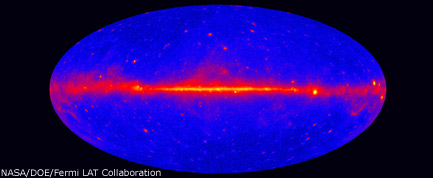Has Dark Matter Finally Been Seen? Time Will Tell

In a new finding that could have game-changing effects if borne out, two astrophysicists think they've finally tracked down the elusive signature of dark matter.
This invisible substance is thought to make up much of the universe — but scientists have little idea what it is. They can only infer the existence of dark matter by measuring its gravitational tug on the normal matter that they can see.
Now, after sifting through observations of the center of our Milky Way galaxy, two researchers think they've found evidence of the annihilation of dark matter particles in powerful explosions.
"Nothing we tried besides dark matter came anywhere close to being able to accommodate the features of the observation," Dan Hooper, of the Fermi National Accelerator Laboratory in Batavia, Ill., and the University of Chicago, told SPACE.com. "It's always hard to be sure there isn't something you just haven't thought of. But I've talked to a lot of experts and so far I haven't heard anything that was a plausible alternative."
Hooper conducted the analysis with Lisa Goodenough, a graduate student at New York University.
Dark matter destruction
The idea of dark matter was first proposed in the 1930s, after the velocities of galaxies and stars suggested the universe contained much more mass than what could be seen. Dark matter would not reflect light, so it couldn't be observed directly by telescopes.
Get the world’s most fascinating discoveries delivered straight to your inbox.
Now scientists calculate dark matter makes up roughly 80 percent of all matter, with regular atoms contributing a puny 20 percent.
The Fermi Gamma-ray Space Telescope, which has scanned the heavens in high-energy gamma-ray light since it was launched in 2008, has observed a signal of gamma-rays at the very center of the galaxy that was brighter than expected. Hooper and Goodenough tested many models to explain what could be creating this light. They ultimately concluded it must be caused by dark matter particles that are packed in so densely that they are destroying each other and releasing energy in the form of light.
Physicists have theorized that dark matter particles might be their own antimatter partners, and thus when two dark matter particles meet under the right circumstances, they would destroy each other. Alternatively, dark matter particles might be meeting anti-dark matter particles at the galactic center.
Either way, the researchers think the Milky Way's gamma-ray glow is caused by dark matter explosions.
By studying the data on this radiation, Hooper and Goodenough calculated that dark matter must be made of particles called WIMPs (weakly interacting massive particles) with masses between 7.3 and 9.2 GeV (giga electron volts) — almost nine times the mass of a proton. They also calculated a property known as the cross-section, which describes how likely the particle is to interact with others.
Knowing these two properties would represent a huge leap forward in our understanding of dark matter.
"It's the biggest thing that's happened in dark matter since we learned it existed," Hooper said. "So long as no unexpected alternative explanations come forward, I think yes, we've finally found it."
The researchers have submitted a paper describing their findings to the journal Physics Review Letters B, but it has not yet gone through the peer-review process.
Some skepticism remains
Not everyone is ready to accept that dark matter has been found.
Hooper and Goodenough based their analysis on data released to the public from the Fermi observatory's Large Area Telescope. However, the official Fermi team, a large collaboration of international scientists, has not finished studying the intriguing glow. While they don't exclude the possibility that it is dark matter, team members are not ready to dismiss the possibility of another explanation.
"We feel that astrophysical interpretations for the gamma-ray signals from the region of the galactic center have to be further explored," said Seth Digel, analysis coordinator for the Large Area Telescope collaboration and a staff physicist at the SLAC National Accelerator Laboratory in Menlo Park, Calif. "I can't and won't say what they've done is wrong, but as a collaboration we don’t have our own final understanding of the data."
Fermi scientists stressed that the analysis of the Milky Way's center is very complex, because there are so many bright sources of gamma-ray light in this crowded region. Various types of spinning stars called pulsars, as well as remnants left over from supernovas, also contribute confusing signals.
"More work needs to be done in this direction, and people within the collaboration are working hard to accomplish this goal. Until this is done, it is too difficult to interpret the data," said Simona Murgia, another SLAC scientist and Fermi science team member.
Promising hints
Hooper agreed that the case is not yet closed.
"I want a lot of people who are experts to think about this hard and try to make it go away," he said. "If we all agree we can't, then we'll have our answer."
One reason he and Goodenough think they are on the right track is that their calculation of the mass of dark matter particles aligns with some promising hints from other studies, he said.
Two ground-based experiments aimed at detecting dark matter have found preliminary indications of particles with roughly the same mass. The University of Chicago's CoGeNT project, buried deep in the Soudan iron mine in northeastern Minnesota, and DAMA, an Italian experiment underground near the Gran Sasso Mountains outside of Rome, both found signals that they can't completely attribute to normal particles, but can't prove are from dark matter.
"Part of why this picture is so compelling has to do with those in fact," Hooper said. "I would argue that it's likely that all three of these experiments are seeing the same dark matter particle."
The Sagan standard
Still, it will take a lot of work to convince most astrophysicists that such a slippery substance has been captured at last.
"It's a complicated task to interpret what Dan and Lisa are seeing," said Doug Finkbeiner, a researcher at the Harvard-Smithsonian Center for Astrophysics in Cambridge, Mass. "I do not find it persuasive, but that doesn't mean it is wrong."
Some scientists said we finally may be getting close to solving the mystery of dark matter. Michael Turner, director of the Kavli Institute for Cosmological Physics at the University of Chicago, said that between Fermi, the ground-based experiments, and the recently opened Large Hadron Collider particle accelerator at the CERN laboratory in Switzerland, scientists will likely confirm the existence of dark matter within the next decade.
For now, though, he's still waiting.
"This result is very intriguing but doesn't yet rise to the Sagan standard — extraordinary claims require extraordinary evidence," Turner said. Other explanations would have to be eliminated, he said. "Nature knows many ways to make gamma rays."



